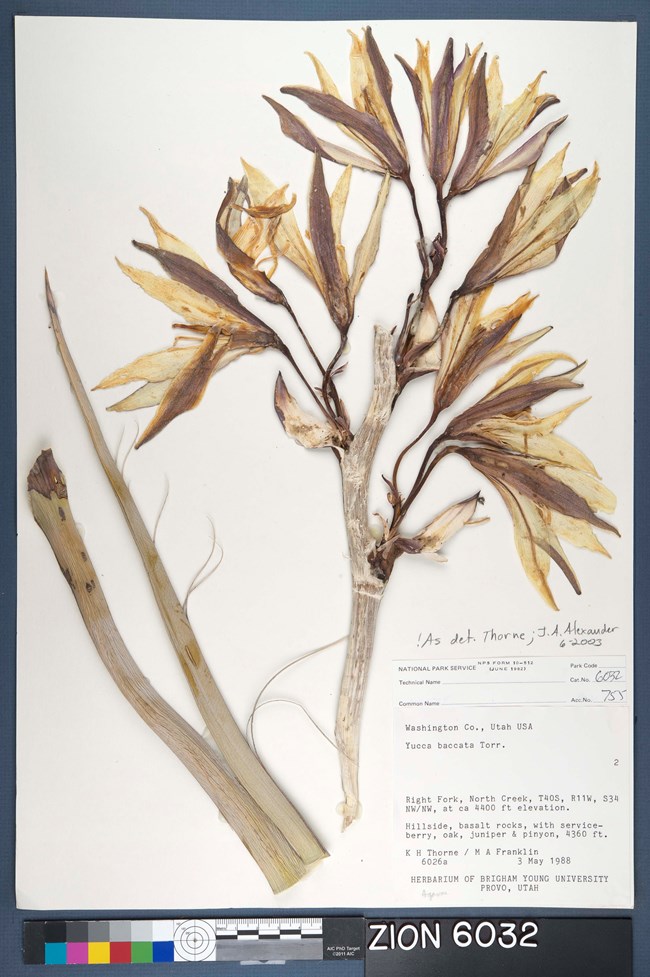
Courtesy Zion National Park, Museum Catalog Number ZION 6032. The collection of plant specimens in Zion’s herbarium is like a botanical treasure chest. At first glance, the dried and pressed plants may not seem to have much value. But the preserved plants represent the fantastic variety of plant life within Zion National Park, provide snapshots of the park’s vegetation at different points in time, and reveal how the park’s first naturalists explored and documented living things. Zion’s herbarium, a part of the park’s museum collection, is a library of plants that has informational, historical, and cultural value. It is used by scientists, educators, and park managers to continue protecting the rich natural world of Zion. With a location at the convergence of three ecological provinces: the Colorado Plateau, the Great Basin, and the Mojave Desert, Zion National Park is home to a remarkable diversity of plant and animal species. The wealth of plant types, including many that are rare and endemic to Zion, is manifest in the herbarium—a collection of over 3,100 plant specimens representing over 95% of the confirmed plant taxa in the park. Each plant is pressed, preserved, and mounted with information on its taxonomy and how and where it was collected. Although the earliest specimens in the herbarium were collected in the 1920s, additions and updates to this resource continue today. Collecting is prohibited in the park, but herbarium specimens are processed by park staff or researchers with permits. The herbarium is used by park staff and outside researchers as baseline data to track changes in park flora over time. The current collection houses over 35 irreplaceable specimens which have not been rediscovered in the park since 1970. These species are categorized as historical records and two are believed to be extirpated from park lands. Thus the herbarium collection may be a useful tool in monitoring human impacts and ecological shifts within this protected area. As time passes, the collection becomes an increasingly valuable resource that will undoubtedly be useful in the future management and protection of Zion’s abundant biological diversity.
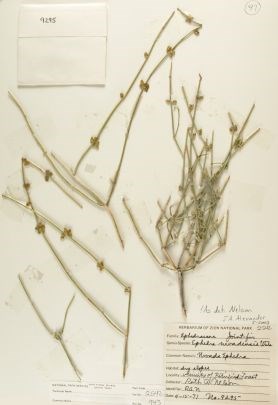
Zion Museum Collection ZION 2542 Mormon TeaThe name of this plant references its use by early Mormon settlers of the area. Although bitter in taste, its thin, light green, jointed stems were used to make tea for medicinal purposes. These stems appear to be leafless but, in fact, have small inconspicuous leaves at each of the nodes on the stems. The leaf size is an adaptation to avoid water loss in this arid climate. From February through April this shrub is covered with small yellow pollen cones contributing to the blooms in the park. This specimen was collected by Ruth Nelson. Nelson collected 850 specimens for the Zion herbarium from 1971-1973 and discovered 119 new taxa for the park while researching her book, Plants of Zion National Park. 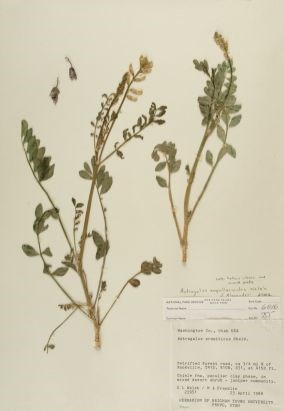
Zion Museum Collection ZION 6016. Shivwits MilkvetchThis species of milkvetch is narrowly distributed only in Washington County, Utah. In 2006 it was reported that there are just over 4,200 individuals in existence, 75% of which are within the boundaries of Zion National Park. This extremely sparse distribution earned Shivwits milkvetch the status as an endangered species on September 28, 2001. In addition to other conservation efforts, Zion’s resource management team has worked to propagate this species in the native plant nursery. Although these plants are threatened by human activities and invasive exotic plants, their population has increased in the past decade. This increase is strongly linked to precipitation and other climatic factors. The growing population has also benefited from the 2,151 acres of protected habitat set aside for this species and speaks to the success of Zion’s conservation efforts. This specimen was collected by Stan Welsh of Brigham Young University. Welsh collected 5 new species for the Zion flora from 1981-1984, including the holotype of Carex haysii with S.L. Clark and Larry Hays in 1984. 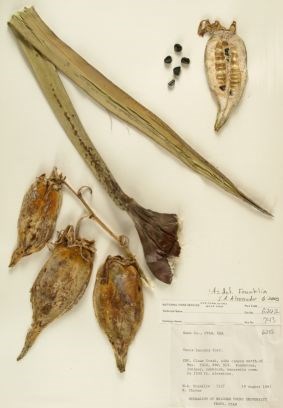
Zion Museum Collection ZION 6032 Datil YuccaWith its rigid spine-tipped leaves, this plant is often mistaken for a century plant – a plant that blooms only once in its lifetime. Although both plants are members of the agave family, Datil Yucca blooms each year. When in bloom, this plant sports white waxy flowers on a large central stalk. The fruit that follows the bloom was eaten ripe, or dried and stored by the Native American inhabitants of this area. They also used the strong fibers of the leaves to make ropes and sandals. The bulbous part of the roots of the Datil Yucca was also eaten and the chemicals in the roots—called Saponins—were used to make soap. 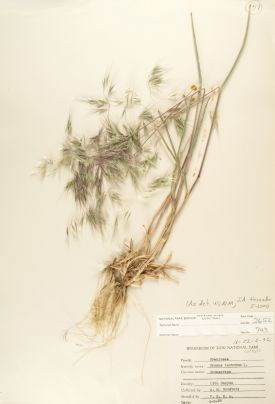
Zion Museum Collection ZION 2652 CheatgrassCheatgrass is a species of exotic grass common in Zion. It has the ability to abruptly change and overtake an ecosystem. The arid southwest is particularly prone to its proliferation because of its ability to germinate in the fall and spring, quickly grow a large root system, produce a profusion of seeds which mature earlier than those of many native grasses, and respond well to disturbance. This plant was introduced inadvertently in the late 1800s, filling voids in the natural ecosystem created by the grazing of livestock. The park’s resource management team has conducted groundbreaking herbicidal treatments to control the undesired growth of cheatgrass in areas affected by fires. The team is also doing extensive research on the best treatment methods to manage this invasive species. Cheatgrass' unfortunate success is still apparent today and poses challenges to the preservation of Zion’s unique native biological diversity. This specimen was collected by Angus Woodbury. Woodbury studied vegetation succession in Zion Canyon and collected over 500 specimens for the ZION herbarium from 1925-1930. His collections resulted in the documentation of at least 287 new species for the Zion flora. Woodsbury published one of the earliest ecological studies of Zion Canyon. 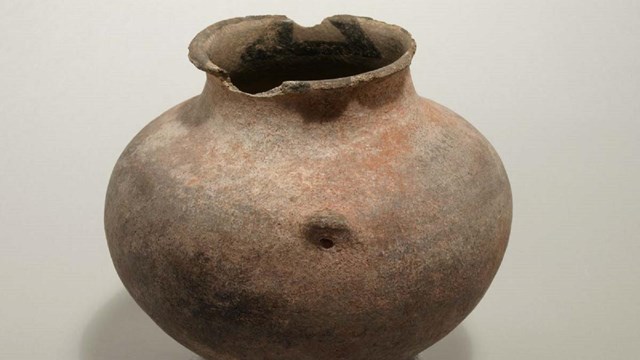
Museum Collections & Archives
Explore museum and archives collections of Zion. 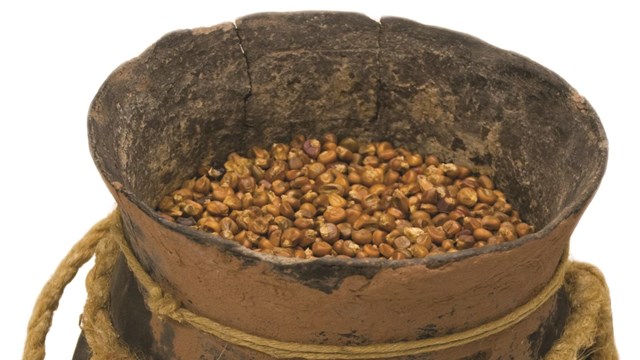
Zion Human History Museum
Discover virtual exhibits and learn more about visiting the Zion Human History Museum. |
Last updated: September 30, 2022
